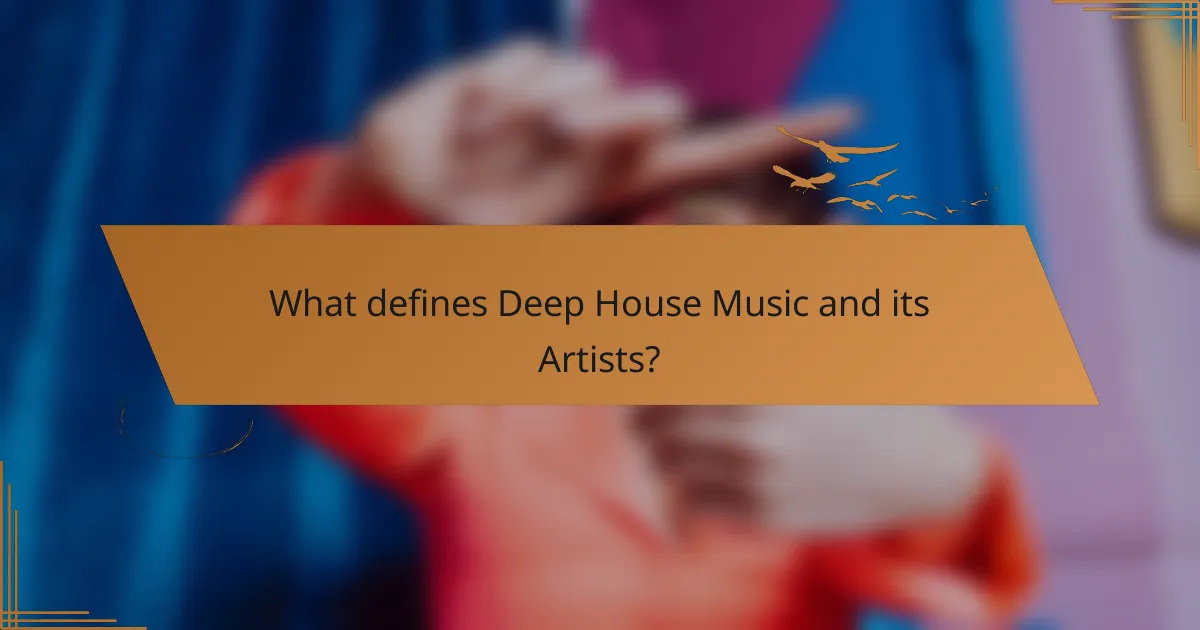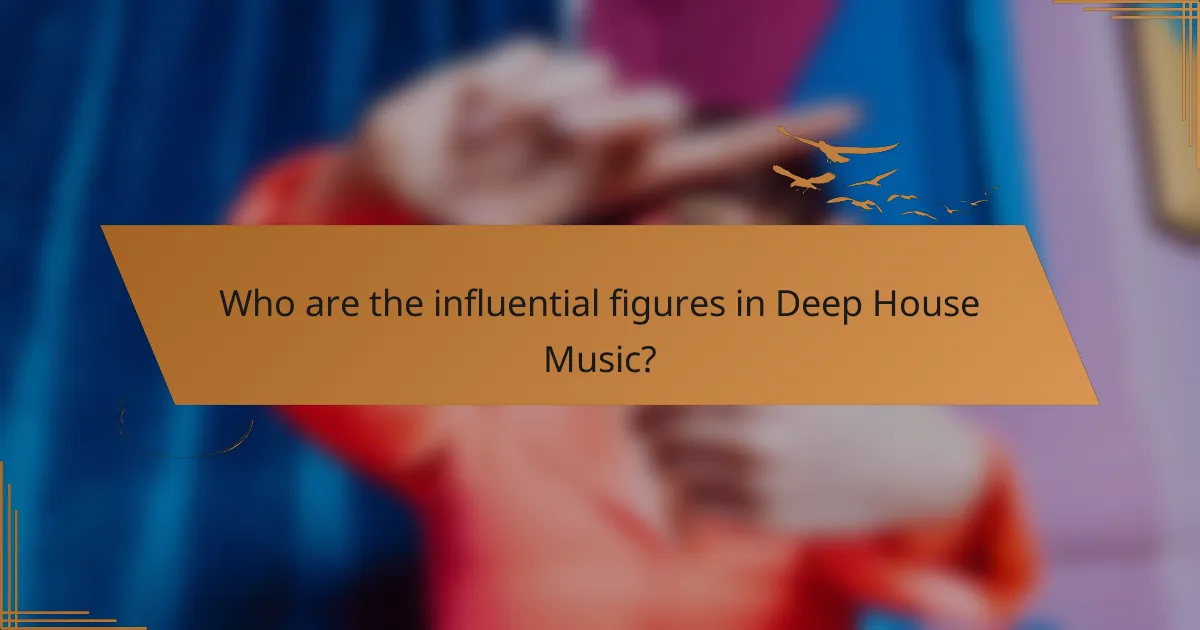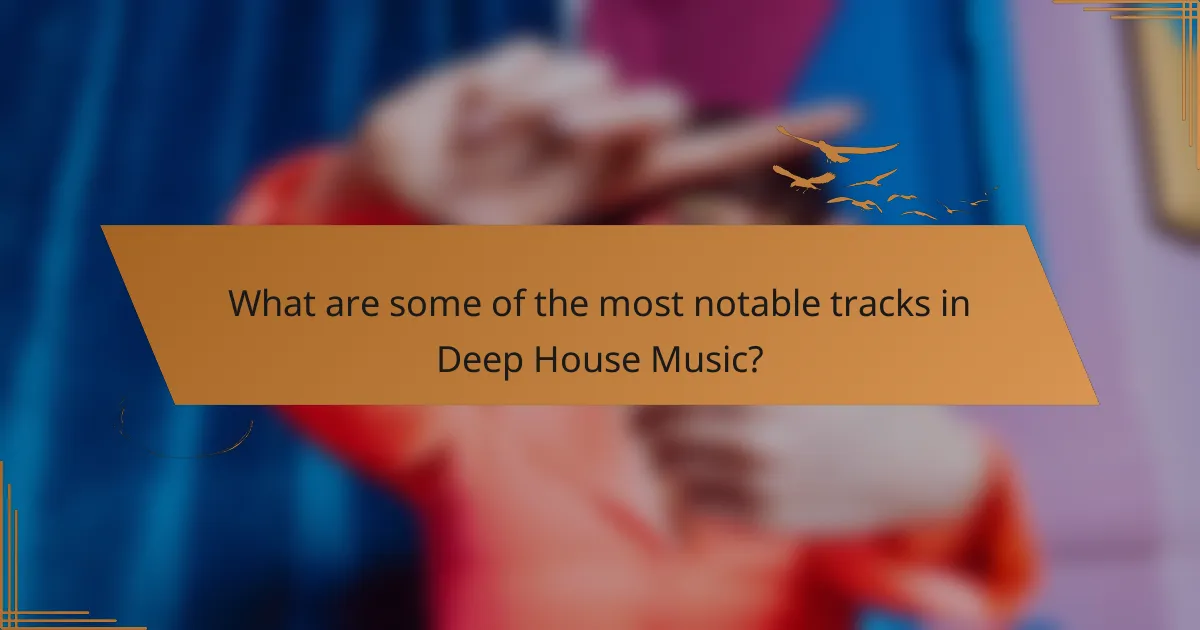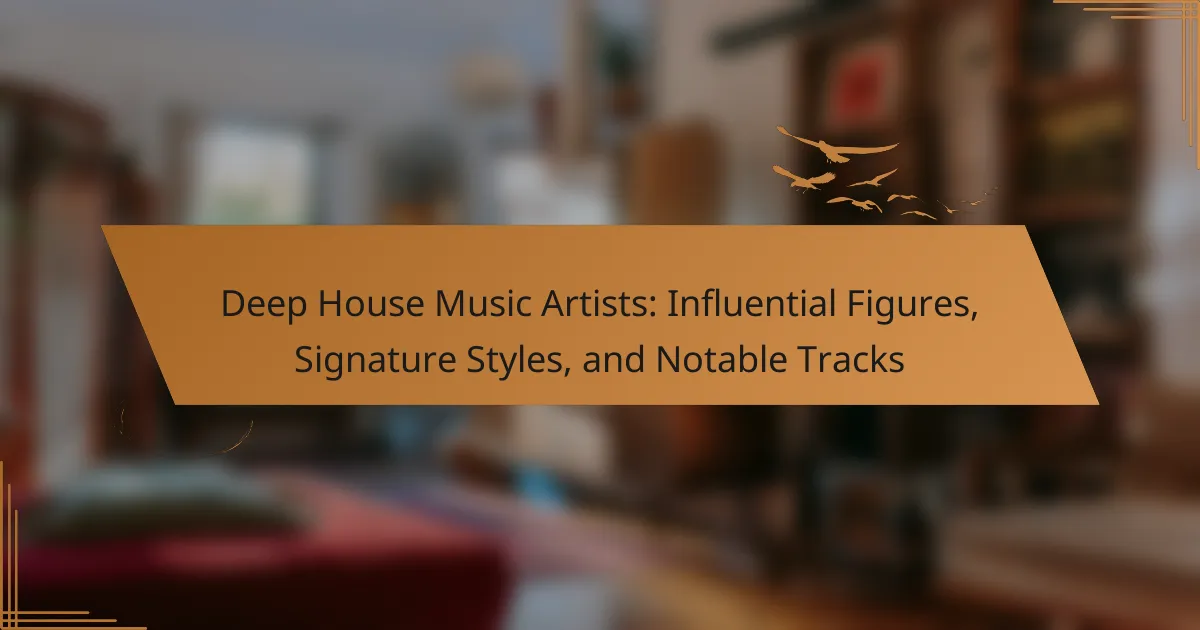Deep House Music is a genre known for its smooth, soulful sound characterized by complex melodies, deep basslines, and atmospheric synths, typically featuring a tempo of 120 to 125 beats per minute. Influential artists such as Larry Heard, Frankie Knuckles, Kerri Chandler, and Maya Jane Coles have significantly shaped the genre since its rise in the 1980s, contributing unique styles and emotive productions. Notable tracks that exemplify Deep House Music include “Can You Feel It” by Larry Heard, “Deep End” by John Summit, and “Cola” by CamelPhat and Elderbrook, each showcasing the genre’s defining characteristics and ongoing influence in modern electronic music.

What defines Deep House Music and its Artists?
Deep House Music is characterized by its smooth, soulful sound and complex melodies. It typically features a tempo range of 120 to 125 beats per minute. The genre incorporates elements from jazz, funk, and soul. Deep basslines and atmospheric synths are prominent features. Artists in this genre often emphasize emotional and melodic elements in their tracks. Notable figures include Larry Heard and Frankie Knuckles, who helped shape the sound. The genre gained popularity in the 1980s and continues to influence modern electronic music. Its unique blend of styles sets Deep House apart from other electronic genres.
How did Deep House Music originate and evolve?
Deep House Music originated in the 1980s in Chicago. It evolved from the combination of jazz, soul, and funk influences. Pioneers like Frankie Knuckles and Larry Heard played significant roles in its development. The genre features a slower tempo and a focus on melodic elements. In the 1990s, Deep House gained popularity in Europe, particularly in the UK and Germany. The sound incorporated elements of techno and house music. By the 2000s, Deep House experienced a resurgence with artists like Miguel Campbell and Duke Dumont. Today, it remains a prominent genre in electronic dance music.
What are the key characteristics of Deep House Music?
Deep House Music is characterized by its smooth, soulful sound and deep basslines. It typically features slower tempos, usually between 120 to 125 BPM. The genre often incorporates elements of jazz, funk, and soul. Vocals are usually soft and melodic, enhancing the emotional depth of the tracks. Additionally, deep house music employs lush synth pads and atmospheric sounds to create a rich auditory experience. The use of sampled sounds and looping is common, adding to the hypnotic nature of the music. This genre emerged in the 1980s and has roots in Chicago house music, contributing to its unique identity.
Who are the pioneers of Deep House Music?
Larry Heard, also known as Mr. Fingers, is a pioneer of deep house music. He produced influential tracks like “Can You Feel It” in the 1980s. Frankie Knuckles, often called the “Godfather of House,” also played a crucial role. His remixes and productions shaped the genre’s sound. Other notable pioneers include Kerri Chandler and Masters At Work. They contributed to deep house’s unique blend of jazz, soul, and funk. These artists laid the groundwork for the genre’s evolution and popularity. Their work remains foundational in deep house music today.
What are the signature styles of notable Deep House Music artists?
Notable Deep House Music artists exhibit distinct signature styles. For example, Larry Heard, known as Mr. Fingers, incorporates lush chords and deep basslines. His tracks often feature soulful vocals and jazzy elements. Another artist, Kerri Chandler, is recognized for his use of organic sounds and intricate rhythms. His style blends house with a touch of garage influences. Maya Jane Coles emphasizes atmospheric soundscapes and emotive melodies. Her productions often include minimalistic beats. Disclosure, a prominent duo, combines deep house with pop elements. They focus on catchy hooks and vibrant production. Each artist’s unique style contributes to the diverse landscape of deep house music.
How do different artists interpret the Deep House genre?
Different artists interpret the Deep House genre in unique ways. Some artists emphasize melodic elements, creating a soothing and atmospheric sound. Others focus on rhythmic complexity, incorporating intricate beats and basslines. For instance, artists like Larry Heard are known for their soulful melodies and jazz influences. In contrast, producers like Maya Jane Coles often blend deep house with tech house, showcasing a more driving beat. Additionally, artists such as Disclosure infuse elements of pop, making their tracks more accessible. Each artist’s interpretation reflects their individual influences and backgrounds, contributing to the genre’s diversity. This variety enriches the deep house scene, appealing to a wide range of listeners.
What instruments and production techniques are commonly used?
Deep house music commonly utilizes synthesizers, drum machines, and samplers. Synthesizers create lush pads and basslines integral to the genre. Drum machines provide rhythmic elements, often featuring deep kicks and crisp hi-hats. Samplers are used to incorporate vocal snippets and various sound bites. Production techniques include layering sounds for depth and using reverb to create space. Sidechain compression is frequently applied to achieve a pumping effect. Equalization and filtering enhance the clarity of individual elements. These instruments and techniques contribute to the signature sound of deep house music.
What impact have Deep House Music artists had on the genre?
Deep House Music artists have significantly shaped the genre’s evolution. They have introduced diverse sounds and innovative production techniques. Their work has expanded the genre’s appeal beyond traditional club settings. Artists like Larry Heard and Kerri Chandler pioneered deep, soulful elements. Their influence is evident in the incorporation of jazz and funk into deep house. Newer artists continue to push boundaries, blending genres like ambient and techno. Collaborations between artists have fostered a vibrant community. The genre now features a wider range of vocalists and instrumentalists. This evolution has helped Deep House gain mainstream recognition and popularity.
How have these artists influenced contemporary music trends?
Deep house music artists have significantly influenced contemporary music trends by integrating elements of jazz, soul, and funk into their productions. This genre has popularized smoother, more melodic sounds in electronic dance music. Artists like Larry Heard and Kerri Chandler have pioneered deep basslines and atmospheric textures. Their work has inspired a new generation of producers, leading to the emergence of subgenres like future house and tech house. Additionally, deep house’s emphasis on vocal samples has shaped mainstream pop music. The genre’s growth in festivals and clubs has further solidified its impact on global music culture.
What collaborations have shaped the Deep House scene?
Collaborations that have shaped the Deep House scene include works by notable artists like Frankie Knuckles and David Morales. Their partnership on tracks like “Your Love” has been pivotal. Another significant collaboration is between Masters at Work and India, producing the iconic “To Be in Love.” This track exemplifies the fusion of soulful vocals with deep rhythms. Additionally, the collaboration between Disclosure and Sam Smith on “Latch” brought deep house into mainstream awareness. These collaborations have influenced the genre’s evolution and popularity.

Who are the influential figures in Deep House Music?
Influential figures in Deep House Music include Larry Heard, known as Mr. Fingers. He is credited with pioneering the genre in the 1980s. His track “Can You Feel It” is a classic example of deep house. Another key figure is Kerri Chandler, who helped popularize the sound with his emotive productions. His work includes the iconic “Bar A Thym.” Additionally, Maya Jane Coles has made significant contributions to the genre with her unique style. Her album “Comfort” received critical acclaim. Other notable artists include Frankie Knuckles, often referred to as the “Godfather of House,” and Theo Parrish, known for his innovative approach to music production. Each of these artists has shaped the sound and direction of deep house music.
What are the most notable Deep House Music artists today?
Some of the most notable Deep House music artists today include Black Coffee, Lane 8, and Disclosure. Black Coffee is renowned for his unique blend of deep house and Afro-house. Lane 8 is known for his melodic and atmospheric productions. Disclosure has achieved mainstream success while incorporating deep house elements into their music. Other significant artists include Solomun and Peggy Gou, who have both made substantial contributions to the genre. These artists frequently perform at major festivals and clubs worldwide, showcasing their influence in the deep house scene. Their tracks often chart on music platforms, demonstrating their popularity and impact in contemporary music.
What are their most significant contributions to the genre?
Deep house music artists have significantly shaped the genre through innovative sounds and production techniques. They introduced complex melodies and rich harmonies, elevating the emotional depth of tracks. Pioneers like Larry Heard and Kerri Chandler emphasized soulful vocals and jazzy elements. Their work laid the foundation for future artists to explore deeper grooves and atmospheric textures. Additionally, artists such as Maya Jane Coles and Disclosure brought mainstream attention to deep house. They incorporated electronic influences and modern production, expanding the genre’s reach. Collaborations with diverse artists further enriched the sound, showcasing its versatility. Overall, their contributions have made deep house a vital part of contemporary music culture.
How have they shaped the sound and style of Deep House Music?
Deep House Music artists have significantly shaped its sound and style through innovative production techniques and unique musical influences. Pioneers like Larry Heard and Kerri Chandler introduced lush, soulful melodies and deep basslines, creating a distinct emotional atmosphere. Their use of jazz and funk elements has influenced the genre’s rhythmic complexity.
Modern artists, such as Disclosure and Maya Jane Coles, have incorporated electronic pop and vocal elements, broadening the appeal of Deep House. The blending of genres has led to a more diverse sound palette, attracting a wider audience.
In addition, the evolution of technology has allowed for new production methods, enhancing the sonic quality of tracks. The rise of digital platforms has facilitated the sharing of Deep House music, further popularizing its sound and style globally.
Which emerging artists are making waves in Deep House Music?
Emerging artists making waves in Deep House Music include Cloonee, who gained recognition for his track “The Calling.” Another notable artist is LP Giobbi, known for her energetic performances and original productions. Additionally, Nala has been praised for her unique sound and collaborations. These artists are part of a new wave revitalizing the genre with fresh perspectives and innovative sounds. Their contributions are shaping the future of Deep House Music.
What unique attributes do these artists bring to the genre?
Deep house music artists bring unique attributes such as innovative sound design, emotional depth, and diverse influences. Their sound design often incorporates intricate melodies and layered textures. Artists like Kerri Chandler and Larry Heard are known for their pioneering use of jazz and soul elements. Emotional depth is evident in their tracks, which often evoke feelings of nostalgia and introspection. Additionally, many artists blend genres, incorporating elements from ambient, disco, and techno. This fusion creates a rich listening experience that sets deep house apart. Notable figures also contribute unique vocal styles, enhancing the genre’s appeal. Overall, these attributes collectively shape the evolution and identity of deep house music.
How are they redefining Deep House Music for new audiences?
They are redefining Deep House Music for new audiences by incorporating diverse genres and modern production techniques. Artists blend elements of techno, jazz, and ambient music into their tracks. This fusion creates a fresh sound that appeals to a wider demographic. Collaborations with mainstream artists also introduce Deep House to pop music fans. Additionally, the use of social media platforms promotes accessibility and engagement with new listeners. Live performances now feature interactive experiences, enhancing audience connection. This evolution reflects changing musical tastes and cultural influences. As a result, Deep House Music continues to grow in popularity among younger generations.

What are some of the most notable tracks in Deep House Music?
Some of the most notable tracks in Deep House Music include “Can’t Get Enough” by Soulsearcher. This track is recognized for its catchy vocals and deep bassline. Another significant track is “Deep End” by John Summit. It gained popularity for its infectious groove and uplifting melody. “So Good to Me” by Chris Malinchak is also a classic, known for its soulful vibe. Additionally, “Cola” by CamelPhat and Elderbrook became a major hit, celebrated for its unique sound and rhythm. Each of these tracks showcases the defining characteristics of Deep House Music.
Which tracks are considered classics in the Deep House genre?
“Deep House classics include tracks like ‘Can You Feel It’ by Mr. Fingers and ‘Deep Burnt’ by Pepe Bradock. These tracks are seminal in defining the genre’s sound. ‘Can You Feel It’ was released in 1986 and is celebrated for its soulful elements. ‘Deep Burnt,’ released in 1996, showcases deep and emotive melodies. Other notable classics are ‘Your Love’ by Frankie Knuckles and ‘I Feel for You’ by Bob Sinclar. These tracks have influenced countless artists and remain staples in Deep House playlists.”
What elements make these tracks stand out?
The elements that make these tracks stand out include unique melodies, rich basslines, and intricate rhythms. Melodies often feature soulful vocal samples or lush synths. Rich basslines provide depth and groove, essential for danceability. Intricate rhythms incorporate syncopation and layered percussion, creating a complex soundscape. Atmospheric elements, such as ambient pads and effects, enhance the overall vibe. Production quality is typically high, showcasing attention to detail. The emotional resonance of the tracks connects deeply with listeners, fostering a strong experience. These characteristics collectively define the distinctiveness of deep house music tracks.
How have these tracks influenced the evolution of Deep House Music?
Notable tracks in Deep House Music have significantly shaped its evolution. They introduced innovative sounds and production techniques. Tracks like “Can You Feel It” by Mr. Fingers set the foundation for the genre’s signature deep basslines and soulful melodies. The use of atmospheric pads and vocal samples became a hallmark of the style. Additionally, “Deep Burnt” by Pepe Bradock showcased complex rhythms and jazz influences. This broadened the appeal of Deep House, attracting diverse audiences. Influential tracks often inspire new artists to experiment within the genre. They also contribute to the genre’s growth in clubs and festivals worldwide. Overall, these tracks have played a crucial role in defining and evolving Deep House Music.
What are the current trends in Deep House Music tracks?
Current trends in Deep House Music tracks include a fusion of genres and an emphasis on melodic elements. Artists are increasingly incorporating live instrumentation, giving tracks a more organic feel. Vocal samples are becoming more prominent, often featuring emotive and soulful performances. There is also a noticeable shift towards deeper basslines and atmospheric soundscapes. Many producers are experimenting with tempo variations, often slowing down the beats to create a laid-back vibe. Collaborations between deep house artists and mainstream pop musicians are on the rise, expanding the genre’s reach. Additionally, the use of technology in production is evolving, with more artists utilizing AI tools for sound design. These trends reflect the genre’s adaptability and its growing influence in the broader music landscape.
How are modern production techniques impacting track creation?
Modern production techniques significantly enhance track creation in deep house music. These techniques include advanced digital audio workstations (DAWs) and software synthesizers. They allow artists to experiment with sound design more efficiently. High-quality plugins enable intricate layering and effects. This leads to more polished and complex tracks. Additionally, modern sampling techniques facilitate the incorporation of diverse sounds. The use of MIDI technology streamlines the composition process. As a result, artists can produce tracks faster and with greater precision. These advancements have transformed the creative landscape of deep house music.
What themes are prevalent in today’s Deep House Music lyrics?
Today’s Deep House Music lyrics often explore themes of love, introspection, and escapism. Love is frequently depicted through emotional connections and romantic experiences. Introspection is conveyed via personal reflections and self-discovery. Escapism is highlighted by the desire to transcend everyday life and seek freedom. These themes resonate with listeners seeking deeper meanings in music. The repetitive and hypnotic nature of Deep House complements these themes, enhancing emotional engagement. Many artists incorporate relatable narratives, creating a strong connection with the audience. The combination of these themes contributes to the genre’s popularity and emotional depth.
What tips can aspiring Deep House Music artists follow for success?
Aspiring Deep House Music artists can achieve success by focusing on several key strategies. First, they should develop a unique sound that reflects their personal style. This differentiation is crucial in a competitive genre. Second, consistent practice and experimentation with production techniques can enhance their skills. Learning software like Ableton Live or FL Studio is beneficial. Third, networking within the music community can open doors for collaborations and gigs. Engaging with other artists and attending events fosters relationships. Fourth, utilizing social media platforms effectively can increase visibility. Regularly sharing music and engaging with fans builds a loyal following. Lastly, understanding the business side of music, including marketing and distribution, is essential for long-term success. Artists should educate themselves on these aspects to navigate the industry effectively.
How can artists develop their unique sound within the genre?
Artists can develop their unique sound within the genre by experimenting with various elements. They should explore different instruments, production techniques, and vocal styles. Collaborating with other artists can also introduce new ideas and perspectives. Analyzing successful tracks within deep house can provide insights into effective sound design. Artists may incorporate personal experiences and influences to create authenticity. Additionally, consistent practice and refinement of their craft are essential. Engaging with their audience through feedback can guide their creative process. These methods have been employed by many successful deep house artists to carve out distinctive identities.
What practices should they adopt for effective music promotion?
Deep house music artists should adopt social media marketing for effective music promotion. Utilizing platforms like Instagram, Facebook, and TikTok can significantly increase their reach. Engaging with fans through regular posts and live sessions builds a loyal following. Collaborating with other artists expands their audience base. Creating visually appealing content, such as music videos or behind-the-scenes footage, captures attention. Utilizing streaming services like Spotify and SoundCloud for distribution is crucial. Artists should also consider email marketing to keep fans informed about new releases. Participating in music festivals and local events enhances visibility and connects artists with potential fans. These practices collectively enhance the effectiveness of music promotion in the deep house genre.
Deep House Music is a genre characterized by its smooth, soulful sound, deep basslines, and a blend of jazz, funk, and soul influences. The article explores the origins and evolution of Deep House, highlighting influential figures like Larry Heard and Frankie Knuckles, as well as modern artists such as Black Coffee and Disclosure. It discusses the signature styles of notable artists, the impact of their contributions on contemporary music trends, and the significance of key tracks that define the genre. Additionally, it addresses emerging artists and current trends in production techniques and lyrical themes, providing insights for aspiring musicians on developing their unique sound and effective promotion strategies.
